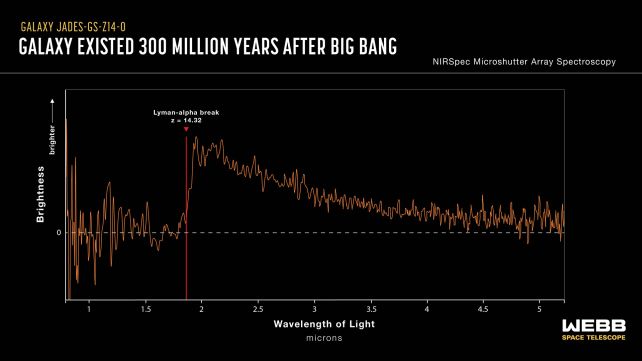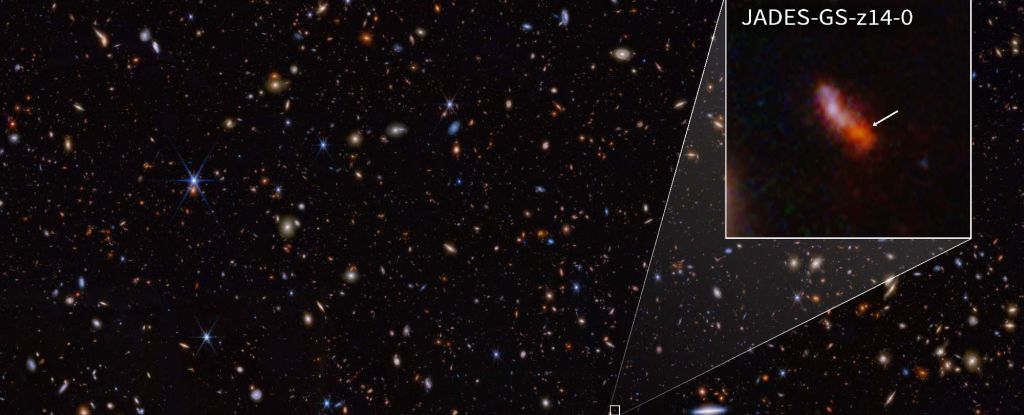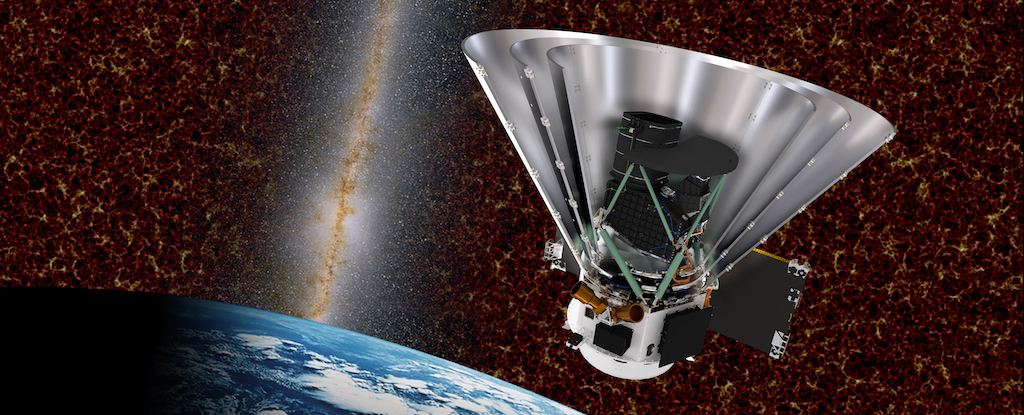A newly discovered galaxy has just smashed the record for the earliest seen yet, presenting a major challenge to our current models of galaxy formation.
It’s called JADES-GS-z14-0, and its brightly gleaming in the early Universe, as it looked less than 300 million years after the Big Bang. A second recent discovery, called JADES-GS-z14-1, was confirmed to be nearly as distant.
The detections, astronomers say, are now “unambiguous“, which means the Cosmic Dawn might have some ‘splainin’ to do.
“In January 2024, NIRSpec observed this galaxy, JADES-GS-z14-0, for almost ten hours, and when the spectrum was first processed, there was unambiguous evidence that the galaxy was indeed at a redshift of 14.32, shattering the previous most-distant galaxy record,” say astronomers Stefano Carniani of Scuola Normale Superiore in Italy and Kevin Hainline of the University of Arizona.
“From the images, the source is found to be over 1,600 light-years across, proving that the light we see is coming mostly from young stars and not from emission near a growing supermassive black hole. This much starlight implies that the galaxy is several hundreds of millions of times the mass of the Sun! This raises the question: How can nature make such a bright, massive, and large galaxy in less than 300 million years?”
Three separate papers have been uploaded to preprint server arXiv. They are yet to be peer-reviewed, but all three have the same conclusion. JADES-GS-z14-0 is definitely there, a shining datapoint that represents a new way forward for understanding how the Universe formed, at the very beginning.
Up until relatively recently, we had very little concrete knowledge about the period known as the Cosmic Dawn, the first billion or so years after the Big Bang 13.8 billion years ago. That’s because the early Universe was filled with a fog of neutral hydrogen that scattered light, preventing it from spreading.
This fog didn’t last; it was ionized and cleared by the ultraviolet light blazed out by objects in the early Universe, and by the end of the Cosmic Dawn, space was transparent.
By then, however, there were a whole bunch of stars and galaxies hanging around. If we want to know how it all formed, we need to be able to see into the fog.
This is one of the things JWST, with its powerful infrared eyes, was designed to do. Infrared radiation is able to travel through dense media other light cannot, its long wavelengths able to pass through with minimal scattering. It’s been conducting the JWST Advanced Deep Extragalactic Survey (JADES), looking for objects in the first 650 million years after the Big Bang, with very interesting results.
One thing that we’ve been repeatedly finding is large objects much earlier than we expect them. That’s been pretty mind-blowing, because we’ve been operating under the assumption that things like supermassive black holes and galaxies take a long time to form – far longer than the timeframe in which we are observing them.
But JADES-GS-z14-0 takes the cake. It’s very large, and very bright, not at all what astronomers have predicted that galaxies look like in the early Universe. Firstly, the size of it shows that most of the light has to be coming from stars, rather than the blaze of light from the space around a growing supermassive black hole.

Analysis of its light reveals the presence of a lot of dust and oxygen, which is unexpected so early on. Such heavy elements would need to be made inside stars which then need to explode. These features suggest that several generations of massive stars must have lived and died already by 300 million years after the Big Bang.
Given that the very largest stars today have lifespans of only around a few million years, that’s not impossible, but still not quite what astronomers expected to find.
All together, the galaxy suggests that we need to rethink the early Universe, showing that the large number of light sources we see there cannot be entirely explained by growing black holes. Somehow, large, bright, well-formed galaxies can assemble early in the Cosmic Dawn.
“JADES-GS-z14-0 now becomes the archetype of this phenomenon,” Carniani says. “It is stunning that the Universe can make such a galaxy in only 300 million years.”
The discovery paper led by Carniani can be found on arXiv. Simultaneous papers studying the properties of the galaxy’s light can be found on arXiv here and here.





